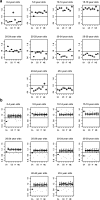Determining the dynamics of influenza transmission by age
- PMID: 24656239
- PMCID: PMC3997935
- DOI: 10.1186/1742-7622-11-4
Determining the dynamics of influenza transmission by age
Abstract
Background: It is widely accepted that influenza transmission dynamics vary by age; however methods to quantify the reproductive number by age group are limited. We introduce a simple method to estimate the reproductive number by modifying the method originally proposed by Wallinga and Teunis and using existing information on contact patterns between age groups. We additionally perform a sensitivity analysis to determine the potential impact of differential healthcare seeking patterns by age. We illustrate this method using data from the 2009 H1N1 Influenza pandemic in Gauteng Province, South Africa.
Results: Our results are consistent with others in showing decreased transmission with age. We show that results can change markedly when we make the account for differential healthcare seeking behaviors by age.
Conclusions: We show substantial heterogeneity in transmission by age group during the Influenza A H1N1 pandemic in South Africa. This information can greatly assist in targeting interventions and implementing social distancing measures.
Figures




Similar articles
-
Estimating age-specific reproductive numbers-A comparison of methods.Stat Methods Med Res. 2018 Jul;27(7):2050-2059. doi: 10.1177/0962280216673676. Epub 2016 Oct 17. Stat Methods Med Res. 2018. PMID: 28571521 Free PMC article.
-
Estimating the reproductive number in the presence of spatial heterogeneity of transmission patterns.Int J Health Geogr. 2013 Jul 26;12:35. doi: 10.1186/1476-072X-12-35. Int J Health Geogr. 2013. PMID: 23890514 Free PMC article.
-
Reproductive number and serial interval of the first wave of influenza A(H1N1)pdm09 virus in South Africa.PLoS One. 2012;7(11):e49482. doi: 10.1371/journal.pone.0049482. Epub 2012 Nov 16. PLoS One. 2012. PMID: 23166682 Free PMC article.
-
Epidemiologic and virologic assessment of the 2009 influenza A (H1N1) pandemic on selected temperate countries in the Southern Hemisphere: Argentina, Australia, Chile, New Zealand and South Africa.Influenza Other Respir Viruses. 2011 Nov;5(6):e487-98. doi: 10.1111/j.1750-2659.2011.00249.x. Epub 2011 Apr 20. Influenza Other Respir Viruses. 2011. PMID: 21668677 Free PMC article. Review.
-
Community interventions in Low-And Middle-Income Countries to inform COVID-19 control implementation decisions in Kenya: A rapid systematic review.PLoS One. 2020 Dec 8;15(12):e0242403. doi: 10.1371/journal.pone.0242403. eCollection 2020. PLoS One. 2020. PMID: 33290402 Free PMC article.
Cited by
-
Statistical Estimation of the Reproductive Number From Case Notification Data.Am J Epidemiol. 2021 Apr 6;190(4):611-620. doi: 10.1093/aje/kwaa211. Am J Epidemiol. 2021. PMID: 33034345 Free PMC article. Review.
-
Synchronicity of influenza activity within Phoenix, AZ during the 2015-2016 seasonal epidemic.BMC Infect Dis. 2017 Jan 31;17(1):109. doi: 10.1186/s12879-017-2197-z. BMC Infect Dis. 2017. PMID: 28143437 Free PMC article.
-
The role of different social contexts in shaping influenza transmission during the 2009 pandemic.Sci Rep. 2014 Nov 27;4:7218. doi: 10.1038/srep07218. Sci Rep. 2014. PMID: 25427621 Free PMC article.
-
Spatiotemporal reproduction number with Bayesian model selection for evaluation of emerging infectious disease transmissibility: an application to COVID-19 national surveillance data.BMC Med Res Methodol. 2023 Mar 14;23(1):62. doi: 10.1186/s12874-023-01870-3. BMC Med Res Methodol. 2023. PMID: 36915077 Free PMC article.
-
Practical considerations for measuring the effective reproductive number, Rt.PLoS Comput Biol. 2020 Dec 10;16(12):e1008409. doi: 10.1371/journal.pcbi.1008409. eCollection 2020 Dec. PLoS Comput Biol. 2020. PMID: 33301457 Free PMC article.
References
-
- Mossong J, Hens N, Jit M, Beutels P, Auranen K, Mikolajczyk R, Massari M, Salmaso S, Tomba GS, Wallinga J, Heijne J, Sadkowska-Todys M, Rosinska M, Edmunds WJ. Social contacts and mixing patterns relevant to the spread of infectious diseases. PLoS Med. 2008;5(3):e74. doi: 10.1371/journal.pmed.0050074. - DOI - PMC - PubMed
Grants and funding
LinkOut - more resources
Full Text Sources
Other Literature Sources

